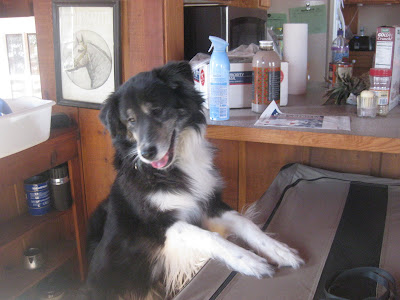Last summer Griffin was lame multiple times. We finally got a
diagnosis of Lyme. We treated him. He got a lot better. But things still weren't quite right. After another episode of lameness
a few weeks ago we re-checked for lyme. His values were much lower and so that was not the problem.
As his recent hip xrays had come back as excellent (yay! And normal elbows!) Our breeder had recommended consulting, as she did last summer,
Debbie Gross Saunders. She's in CT, "only" 13 hours away. To our luck, she would be giving a seminar locally! She does speaking all over, does a lot of education with vet-type professionals, and
creates resources and articles for dog-sport people [not all of those are hers, but many are].
We (Griffin, the breeders, and I!) begged to get a private lesson spot. The hosts had none available, we thanked them and said if that changes to PLEASE let us know. To our luck, a spot opened up!
And... we found out that Griffin has a
mild psoas injury. The good news? It's mild and there's a lot we can do to help him get better. But it's something we'll have to be very careful to prevent any re-occurring problems in the future.
The psoas injuries in dogs are not uncommon, and while agility is often blamed, dogs can get even just running outside on a slippery surface. This muscle connects the rear leg to the back and can be very painful for the dogs. The injuries can be hard to diagnose as the average pet owner probably won't notice some of the minor symptoms and regular vets aren't typically able to figure out what's going on.
For two weeks we will be:-
Heat twice a day for 15 minutes. I'm really not sure how I'll do this. We have a heated dog bed that he likes. But that won't quite be in the right place.
- Hikes! We can go out off leash if the ground isn't slippery! I'm so excited! We've done a little of this because Griffin convinced me so. However, I was always hesitant we could be making it worse. We'll use moderation. Start out on leash and then do a bit of stretching before letting him go.
- Work on an exercise ball: We have a few different activities to do on here to work on his balance and strength.
- Stretches: Stretching out the rear leg and a turning-to-the-side stretch. It will take a bit of work to get him not to be distressed by the handling.
- Hill walking: Slowly up and down, only a few times a week. We'll probably do this in conjunction with our off leash walks.
- We CAN still do agility in moderation: Yay! So we'll be able to find a class! And keep working on our own too! I was really surprised this was going to be something we could do so soon.

After two weeks we'll be checking back in. Hopefully before then we'll be able to find someone near us to help adjust the exercises and monitor our progress.
Now to the Griffin part:- His favorite part: When she asked to see him move....off leash. He got to run around. I was not happy he wandered around so much. But he was cute running (as he always is!).
- He did NOT like the handling/manipulation/stretching demos: Obviously there was pain and he doesn't like pain. He did his adorable growling for part of it. But we were able to figure out enough of what was going on. I tried to feed him throughout but he was too stressed to eat.
- Stretching demos: Just didn't work. But luckily I had Blaze in the car and he's great for that sort of thing. I was able to learn what I needed to do without stressing out my dog more than he already had been.
- Debbie noticed a shortened stride when he ran. I can see that when it's pointed out, but I hadn't specifically noted this. I'll be watching to see how this changes over time.
- At camp last year,
Megan noted that
he doesn't stack perfectly. I don't remember which parts she saw were off... but today it was noted that his left rear toe points out just slightly. We'll be working to correct this and then all should be well.
His breeders had recommended Debbie very highly, but I wasn't quite sure what to expect. I'd read her (not so recent )
book a few months ago and watched her exercise ball DVD, but was a bit hesitant about some of the dog handling on there while recognizing that it can be stressful for the human and dog to be doing video and getting things done in an appointment.
It was a great experience! I'm always interested in the "people teaching" part of animal professionals, and she definitely did a -great- job with that. She was able to explain what was going on and what I needed to do without 'watering it down'. Great as professional. Great as a speaker-educator with non-vet-type professionals. It was also really cool that she knows his family and breeders and was able to comment on some of the silly little things his mom does. I'll be going to parts of the seminar this weekend and will be taking a lot of notes. I really wish I was closer and could keep taking Griffin to her.
It's just so neat/happy/exciting to keep hearing little things from different people, all over, about his family, I'm really glad to know them the little bit I do.
So now I get to join the injured-dog-club. But I don't plan on having my membership for long!


















